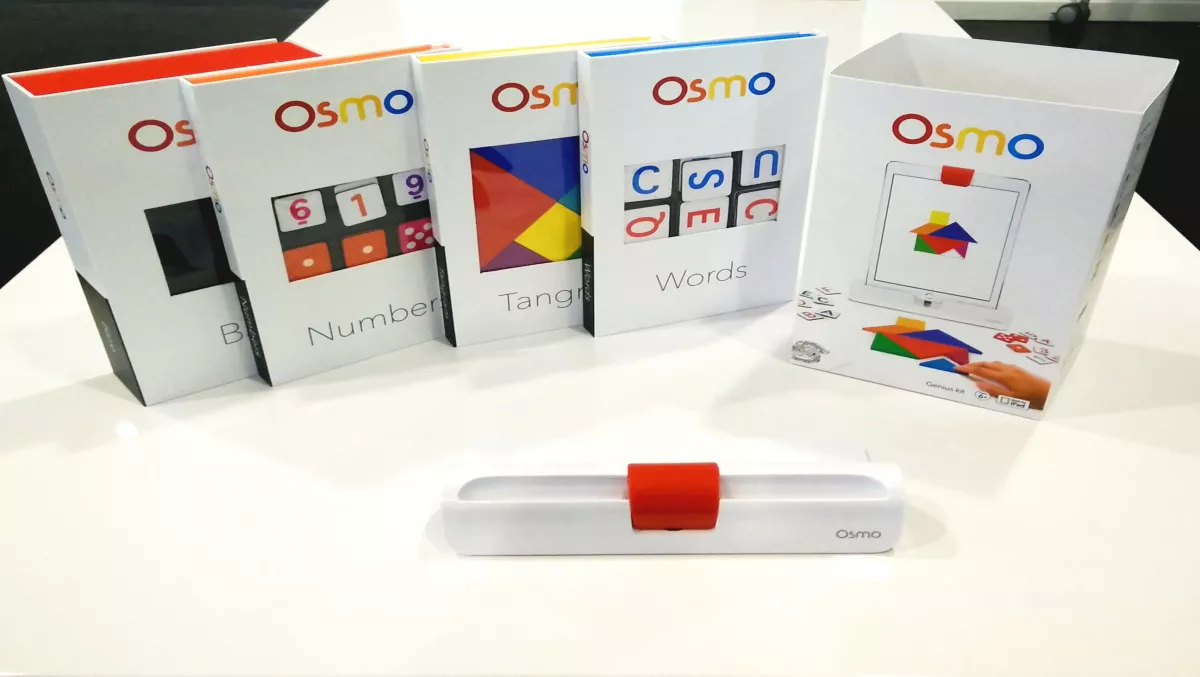
Hands-on review: Osmo Genius Kit for classroom or parenting
The Osmo Genius Kit is the type of product that splits you into two different people when using it.
Part of you is excited about the educational possibilities, the ways you can inspire children and help them to learn. The other part becomes that child, completely wrapped up in the fun, educational play.
The Osmo is a clever iPad game with tangible real-world interaction, allowing your physical actions to generate on-screen outcomes.
Simply by slipping the little red peripheral over your iPad, Osmo converts your humble front-facing camera into something quite different.
With the use of mirrors and some very intuitive colour recognition, the player places tiles, shapes, numbers and letters in front of the, now downward facing, camera to control the games on-screen.
A very tidy package, Osmo comes in a clip together magnetised bundle that keeps everything in together.
There must have been a surplus of nifty magnets lying around the Osmo design floor, as the whole kit has little magnetic doors and attachments that sit neatly together when not being used.
In only minutes the Osmo is set up, with a simple email registration and some downloads from the app store. Then, you're ready to play - and learn.
The Games:
First in the stack is Tangram. A nostalgic throwback to wooden puzzle pieces, now with a gadget integration twist.
The tangram game challenges players to quickly assemble the challenges onscreen to progress through a map of animated family fun. These challenges range from basic shapes to complex animals and people.

The next part of the kit to test was my arch nemesis: Numbers. To my surprise the math game is incredibly fun and even taught me a thing or two. Players move through an increasingly difficult sea of challenges, popping bubbles with numbers made from the stack of tiles in your genius kit.
The challenges are varied and fun while also encouraging an instinctive use of math I wish I'd had as a young learner. Making rapid additions and decisions on the fly really ups the learning speed with this game.
A great way to engage children lagging behind in math or struggling with the rote-learn nature of math problems.

Next up: Words. If you feel at home in the etymological world you'll love this game. Gameplay is a kind of speed-hangman game where multiple players can quickly guess the word from cryptic image clues.
To test the app, I ramped the difficulty up to impossible and found that it almost had a wordsmith like myself flummoxed a few times. There is great replayability and with such an expansive difficulty range could be used in multiple year groups.
The Newton kit challenges players to interact with a series of physics puzzles with drawing. Balls fired out of a cannon will bounce off the lines the players draws in front of the camera. Using your little lines you must bounce these balls into various targets to beat levels.
This game is very clever but can often be halted by a few annoying snags. Balls will often pile up, causing the whole puzzle to lose momentum as they don't disappear after a certain time. This can be fixed by pulling your drawing surface away from the camera, though this often takes you back to square one.
The last two aren't so much games as just fun little tools. Masterpiece lets you turn images into traceable lines, meaning you can draw along to the app and create your own art.
Monster, the last part of Osmo, gives you a virtual buddy to interact with. He speaks to the player and pulls their drawings up on screen to play with and complete challenges.
Sadly, monster is a little tedious and you'll find your little guy dragging up parts of your fingers and any faint scribbles on the page as well as your drawing.

The first thing you'll notice about the suite is that it's very intuitive. Games will often give you subtle, non-condescending, hints if a particular challenge is taking too long.
Incredible product and packaging design.
You'll also be surprised at how responsive the camera is, it can pick up the tiles from quite far away impressively accurately.
It is genuinely very fun.
It managed to make me enjoy math which can only be a good thing.
The Bad:The kit retails for around $170, meaning it's a bit over the average classroom budget; especially for a product that can only be used by a couple of students at a time.
If you don't want to buy Osmo's drawing peripheral, I would recommend a small whiteboard as you will go through trees of paper with the drawing apps.
Some of the bugs pull you out of the experience completely, and what was once a fun, engaging activity, becomes a chore.
Really only one or two players can interact with Osmo at a time, so it is probably more suited for home than the classroom.
The set is iPad exclusive, which cuts a huge part of the audience out.
Verdict:All in all, Osmo is a very cool package, with some impressive technology under the hood.
The set has been available for a while overseas but was released in New Zealand late last year. So, a lot of the early bugs have already been ironed out, which makes the user experience really polished.
It looks amazing and is genuinely fun, while encouraging a lot of learning.
I can recommend Osmo to any education providers with a lab, or a budget for tech that doesn't need to engage the whole class at once. Or to families who want to supplement school learning with some engaging activities at home.
If you want something smart, with some very impressive packaging and design, and can afford a one or two player experience get yourself an Osmo.
It's a great way to balance screen time with learning as well as keeping hands and minds busy.

